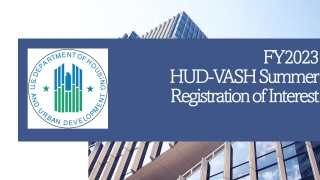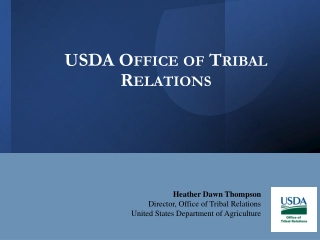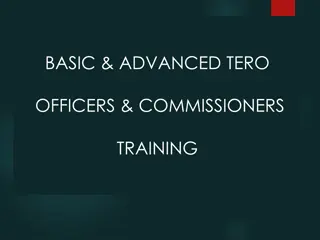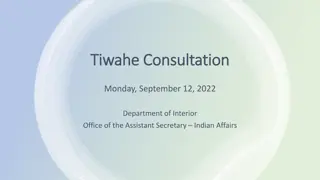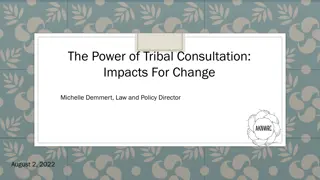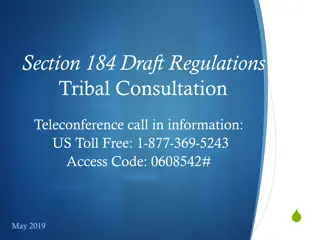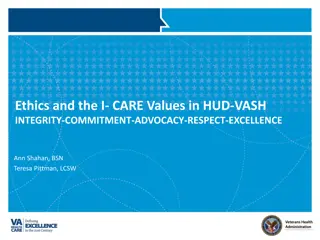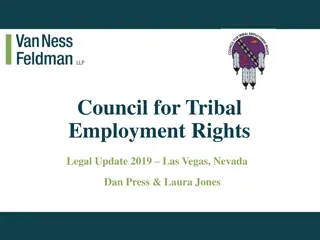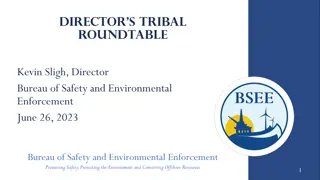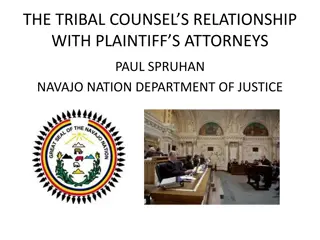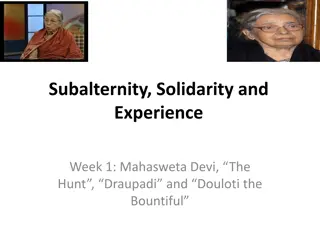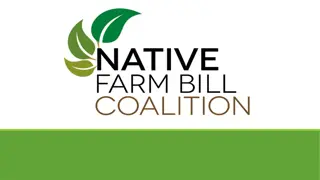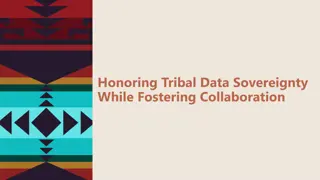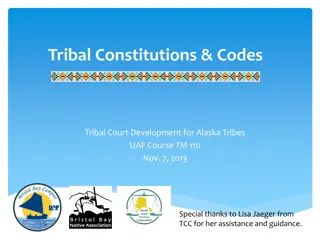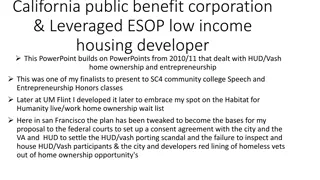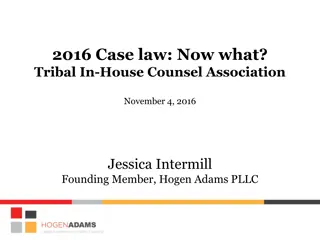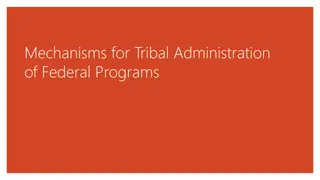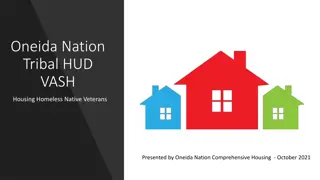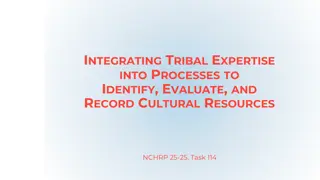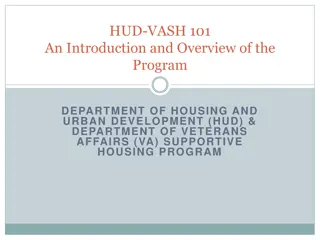Tribal HUD-VASH Live Meeting Overview
Tribal HUD-VASH program in partnership with the VA and HUD provides supportive housing for homeless Veterans. Today's meeting features Teresa S. Pittman, discussing the background, Housing First model, partnership details, VA's role, and case management options. The program aims to house clients first and offer supportive services, emphasizing housing stability. VA is responsible for case management and supportive services, with various ways to provide these services. Partnership details include inviting tribes, awarding units, providing rental assistance, and VA case management coordination. Local VA centers consult with tribes to determine the best approach for case management services.
Uploaded on Sep 15, 2024 | 1 Views
Download Presentation

Please find below an Image/Link to download the presentation.
The content on the website is provided AS IS for your information and personal use only. It may not be sold, licensed, or shared on other websites without obtaining consent from the author.If you encounter any issues during the download, it is possible that the publisher has removed the file from their server.
You are allowed to download the files provided on this website for personal or commercial use, subject to the condition that they are used lawfully. All files are the property of their respective owners.
The content on the website is provided AS IS for your information and personal use only. It may not be sold, licensed, or shared on other websites without obtaining consent from the author.
E N D
Presentation Transcript
TRIBAL HUD-VASH LIVE MEETING Begins @ 1:00 pm EST For Audio Dial: (877) 873-8017 Access Code 7326388 PRESS *6 to mute/unmute your phone
Todays Presenter Teresa S. Pittman LCSW HUD-VASH Region 1 Coordinator (VISNs 1-5, 9 and 23) Department of Veterans Affairs Central Office
HUD-VASH Background Created in 2008 as a partnership between HUD and Veterans Affairs to provide Supportive Housing to homeless Veterans. Targets the most vulnerable homeless Veterans by combining healthcare and housing: VA provides case management & supportive services HUD provides rental housing assistance vouchers to Public Housing Authorities (PHAs) Housing First Approach
HOUSING FIRST MODEL Clinical approach House the client First, then wrap supportive services around the client Fewer access barriers treatment not required for housing Treatment available client goals primary Goal is housing stability and meeting tenancy Expect the client to meet tenancy requirements
Partnership HUD - Housing Invite 30 tribes to participate Award 15 to 25 units per tribe Provide rental assistance (based on Fair Market Rents), and administrative fee VA Case Management Coordinate with tribe on best delivery of case management and supportive services. Obtain 30 case managers Provide continuing assistance and care
VAs Role Case Management and Supportive Services
VA Case Management VA will have three potential ways to provide the case management and supportive services: 1. Hire the case manager (VA Employee) 2. Enter an Interagency Agreement with the local Indian Health Service facility (IHS Employee) 3. Obtain a contract with the Tribal Health Service (if no IHS facility) - (Tribal Health Service Employee)
Process Local VA Medical Center leadership to consult with tribes and the local IHS (if available) to determine the best way to provide the case management and supportive services. VA makes the final determination regarding how VA will meet the case management requirement. One case manager per 15-25 vouchers, total of 30 case managers for the Tribal HUD-VASH program (one per tribe invited to participate).
Benefits If there are tribal members who are social workers or nurses with the proper credentialing, then they could be hired by VA: VA would provide salary, car access, laptop, cell phone, etc. If IHS or Tribal Health Service provides the case manager, then VA provides: Salary, and A portion of the car lease cost
Role of the VA Case manager Providing outreach services to Veterans experiencing homelessness/at risk of homelessness Verifying Veteran s eligibility status Assessing Veteran and determining case management needs Providing access to appropriate treatment and supportive case management services
Role of the VA Case Manager Helping the Veteran obtain the rental assistance from tribe/TDHE Providing housing search assistance Connecting with potential landlords Home visit check-ins with Veteran Connect the Veteran to needed resources Build skills communication, tenancy, others Provide support and treatment
VHA Eligibility Complicated VA has an eligibility department to help determine status Generally before 1980 served 180 days or more; after 1980, served 2 years or more Discharged with Honorable or Under Honorable Conditions no Dishonorable Verified by DD-214 (Discharge papers) VA Medical Center, Community clinics, Vet Centers, IHS facilities can determine VHA eligibility
Housing Search Landlord recruitment Housing Authority list/assistance Landlord Fairs Available housing stock Veteran preferences Unit Size based on family size Case manager helps with viewing the unit, getting the inspection & lease signed
Housing Case manager helps with move-in Plan Deposits (if needed) for utilities/security deposit Furniture (as available) Other items needed towels, sheets, cleaning supplies, dishes, cooking implements, etc. Donations some drives specifically for Veteran housing Community supports
Supportive Services Range from connecting with medical, mental health and substance use disorder treatment to providing some of this treatment Practical assistance with tenancy requirements Assist with independent living Engage Veteran with other resources and activities to encourage community
Q & A What is required to be Health Care eligible? What type of discharge status is needed? What is at-risk of homelessness? What are supportive services? How do we locate private landlords? How do we connect with our VAMC contact? Does the VA have marketing materials? Other questions?
VA Contact Teresa S. Pittman LCSW HUD-VASH Region 1 Coordinator (VISNs 1-5, 9 and 23) Department of Veterans Affairs Central Office 202-632-8597 Teresa.Pittman@va.gov
HUD/ONAP Contacts Iris Friday, iris.friday@hud.gov 206-220-5420 Nick Zolkowski, nicholas.c.zolkowski@hud.gov 202-402-4507 tribalHUDVASH@hud.gov Updates on www.hud.gov/codetalk
HOMELESS (McKinney-Vento) (1) An individual or family who lacks a fixed, regular, and adequate nighttime residence An individual or family with a primary nighttime residence that is a public or private place not designed for, or ordinarily used as, a regular sleeping accommodation for human beings, including a car, park, abandoned buildings, bus, or train station, airport, or camping ground. An individual or family living in a supervised publicly or privately- operated shelter designated to provide temporary living arrangements (including hotels and motels paid for by Federal, state, or local government programs for low-income individuals or by charitable organizations, congregate shelters, and transitional housing). An individual who resided in a shelter or a place not meant for human habitation and who is exiting an institution where the individual temporarily resided. (2) (3) (4)
HOMELESS cont. (5) An individual or family who: (A) Will imminently lose their housing, including housing they own, rent, or live in without paying rent, are sharing with others, and rooms in hotels or motels not paid for by Federal, state, or local government programs for low-income individuals or by charitable organizations, as evidenced by: (i) A court order resulting from an eviction action that notifies the individual or family that they must leave in 14 days; (ii) The individual or family having a primary residence that is a room in a hotel or motel and where they lack the resources necessary to reside there for more than 14 days; or (iii) credible evidence indicating that the owner or renter of the housing will not allow the individual or family to stay for more than 14 days, and any oral statement from an individual or family seeking homeless assistance that is found to credible shall be considered credible evidence for purposes of this clause;
HOMELESS cont. (B) has no subsequent residence identified; and (C) lacks the resources or support networks needed to obtain other permanent housing; and (6) Unaccompanied youth and homeless families with children and youth defined as homeless under other Federal statutes who-
HOMELESS cont. (A) have experienced a long term period without living independently in permanent housing, (B) have experienced persistent instability as measured by frequent moves over such period, and (C) can be expected to continue in such status for an extended period of time because of chronic disabilities, chronic physical health or mental health conditions, substance addiction, histories of domestic violence or childhood abuse, the presence of a child or youth with a disability, or multiple barriers to employment.
At Risk of Homelessness AT RISK OF HOMELESSNESS The term at risk of homelessness means an individual or family, that (A) has income below 30 percent of median income for the geographic area; (B) has insufficient resources immediately available to attain housing stability; and (C)(i) has moved frequently because of economic reasons; (ii) is living in the home of another because of economic hardship; (iii) has been notified that their right to occupy their current housing or living situation will be terminated; (iv) lives in a hotel or motel; (v) lives in severely overcrowded housing; (vi) is exiting an institution; or (vii) otherwise lives in housing that has characteristics associated with instability and an increased risk of homelessness.


